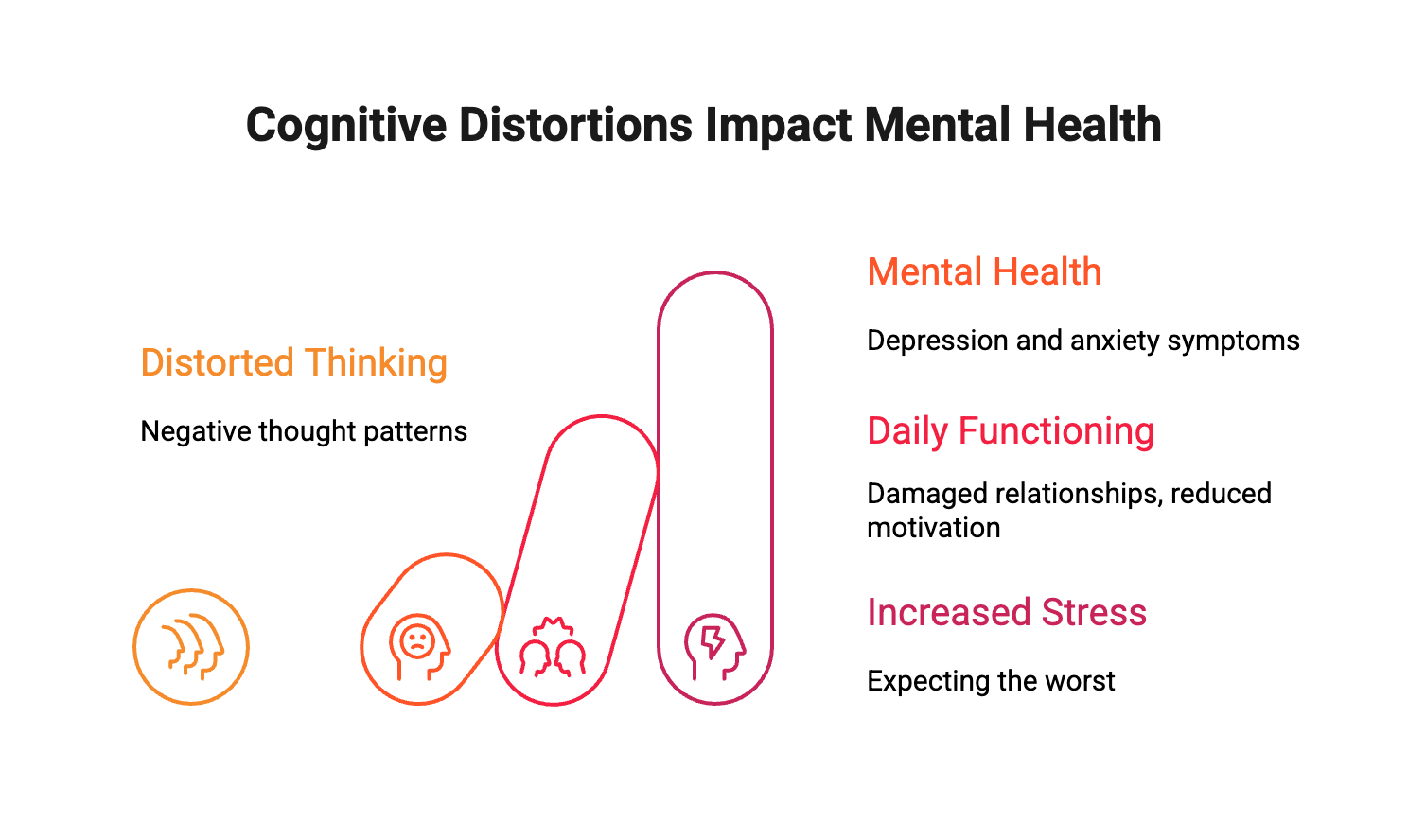What Are Cognitive Distortions? A Guide to Understanding Your Negative Thinking Patterns
Have you ever noticed your mind jumping to the worst possible conclusion, even when the evidence doesn’t support it? Or found yourself thinking in extremes—everything is either perfect or a total failure? These are examples of cognitive distortions, negative thinking patterns that twist reality and significantly impact your mental health. Understanding these distorted thinking patterns is the first step toward challenging them and developing healthier thought patterns.
What Are Cognitive Distortions?
Cognitive distortions are inaccurate or exaggerated thought patterns that reinforce negative emotions and beliefs. These thinking errors happen automatically, often without you realizing it, and make situations seem worse than they are. Cognitive distortions are linked to conditions like anxiety and depression, but everyone experiences them to some degree.
Think of cognitive distortions as mental shortcuts gone wrong. Your brain processes information quickly, but sometimes takes shortcuts that lead to distorted thinking. Instead of seeing situations clearly, you filter out positive aspects and focus only on negatives, or jump to conclusions without enough evidence.
The concept comes from cognitive behavior therapy, developed by psychiatrist Aaron Beck, whose work showed that thoughts, feelings, and behaviors are connected—and when thinking patterns become distorted, emotional well being suffers.
Which Are Examples of Cognitive Distortions?
The most common cognitive distortions fall into several recognizable categories. Learning to identify these patterns in your own thinking is key to addressing them. Each cognitive distortion has its own signature pattern, though they often overlap.
All-or-Nothing Thinking
All or nothing thinking (also called polarized thinking or black and white thinking) means seeing things in extremes. If you don’t do something perfectly, you view it as a total failure. There’s no in between. This is one of the most common cognitive distortions. For example, if you make one mistake at work, you might think, “I’m terrible at my job,” ignoring all the things you do well. Polarized thinking leaves no room for nuance or partial success.
Mental Filtering
Mental filtering involves focusing exclusively on negative aspects of a situation while ignoring positive aspects. You might receive positive feedback on a project but fixate on one small criticism, letting it overshadow everything else. This negative bias can make it hard to recognize your successes.
Emotional Reasoning
Emotional reasoning is when you assume your feelings reflect reality. If you feel anxious about an upcoming event, you conclude something bad will happen. Research shows that emotional reasoning strengthens the connection between distorted thoughts and negative emotions.
Mind Reading
Mind reading means assuming you know what others are thinking—usually something negative about you. You might think, “They didn’t respond to my text, so they must be angry with me,” without any real evidence. This is a form of jumping to conclusions that can damage relationships and increase anxiety.
Fortune Telling
Catastrophizing (or fortune telling) involves predicting the worst possible outcome. One small setback becomes a sign that everything will fall apart. This cognitive distortion can fuel heightened anxiety and make future events seem threatening.
Overgeneralization
Overgeneralization happens when you take one event and assume it represents a never ending pattern. If someone rejects you once, you might think, “I’ll never find a relationship,” turning a single event into a sweeping conclusion.
Personalization
Personalization means taking blame for things outside your control or assuming everything relates to you. If a friend seems upset, you immediately think you did something wrong, even when their mood has nothing to do with you.
Should Statements
“Should” statements create rigid rules about how you or others must behave. When these rules are broken, you feel guilty, frustrated, or angry. Phrases like “I should be better at this” or “They should have known” reflect this cognitive distortion.
Key Insight: These common cognitive distortions often work together, creating thinking errors that reinforce negative thought patterns and distorted thoughts. Recognizing even one or two in your daily life is a powerful first step.
Why Do Cognitive Distortions Matter?
Cognitive distortions directly impact your mental health by maintaining and intensifying negative emotions. When you consistently engage in distorted thinking, it affects how you feel about yourself, your relationships, and your life.
Studies indicate that cognitive distortions contribute to symptoms of depression and anxiety. They lower self esteem, increase negative self talk, and create a cycle where negative thoughts lead to unpleasant feelings, which generate more distorted thoughts.
Beyond mental health conditions, cognitive distortions affect daily functioning. They damage relationships through mind reading or assigning blame. They reduce motivation when all or nothing thinking makes tasks seem impossible. They create unnecessary stress when catastrophizing turns ordinary situations into threats.
Worth Noting: Research shows that cognitive distortions have increased in recent decades. Social media, constant news cycles, and adverse life events may all contribute to these patterns becoming more common.
The good news? Identifying cognitive distortions is valuable because these patterns are changeable. Distorted thinking can be recognized, challenged, and replaced with more balanced perspectives.
How to Stop Cognitive Distortion?
Stopping cognitive distortions starts with awareness—learning to catch these automatic thoughts as they happen. Once you can identify them, you can challenge and reframe them using techniques from cognitive behavioral therapy.
Track Your Thought Patterns
Keep a thought record to track your thinking patterns. When you notice a strong negative emotion, pause and write down the situation, the thought, and how it made you feel. Over time, you’ll recognize which cognitive distortions you use most often—whether it’s jumping to conclusions, mental filtering, or another pattern.
Challenge the Evidence
Challenge your negative thoughts by examining the evidence. Ask yourself: What facts support this thought? What contradicts it? Am I considering all the information? This process, called cognitive restructuring, helps you see situations realistically.
Remember: The goal isn’t to think positively all the time—it’s to think more accurately. Sometimes situations genuinely are difficult. Balanced thinking acknowledges both challenges and strengths without falling into extremes.
Test Your Predictions
Test your predictions in the real world. If you’re catastrophizing about a presentation, go through with it and observe what actually happens. Often, your negative predictions don’t match reality.
Reframe Distorted Thoughts
Practice reframing cognitive distortions by replacing extreme thoughts with balanced ones. Instead of “I always mess up,” try “I made a mistake this time, but I’ve succeeded before.” Look for positive ways to interpret neutral situations.
Use Mindfulness
Mindfulness helps you observe thoughts without immediately believing them. When you notice all or nothing thinking, you can acknowledge it—”I’m having that black and white thought again”—without acting on it. This creates space between the thought and your response.
What Are the 3 C’s of Cognitive Reframing?
The 3 C’s of cognitive reframing provide a simple framework for challenging cognitive distortions: Catch it, Check it, Change it.
Catch it means noticing when you’re engaging in distorted thinking. You might catch yourself thinking, “Nobody likes me” after one awkward interaction, or “This will be a disaster” before an important event.
Check it involves examining whether the thought is accurate. Look at the evidence objectively. Are you engaging in mind reading without real information? Are you filtering out positive experiences? This step separates realistic concerns from thinking errors.
Change it means replacing the distorted thought with a more balanced alternative. Find a perspective that acknowledges both challenges and strengths, considers multiple possibilities, and avoids extremes.
When Should You Seek Professional Help for Cognitive Distortions?
If cognitive distortions are interfering with your daily life, relationships, or mental health, it may be time to work with a mental health professional. While everyone experiences distorted thinking occasionally, persistent negative thought patterns often benefit from professional support.
Consider reaching out to a therapist if cognitive distortions contribute to ongoing anxiety, depression, or low self esteem. Research documents significant connections between distorted thinking and conditions like social anxiety disorder, generalized anxiety disorder, and panic disorder.
Professional help is especially valuable when cognitive distortions create tension in relationships or prevent you from pursuing goals. Therapists who specialize in cognitive behavioral therapy can teach you personalized cognitive restructuring techniques and guide you through reframing cognitive distortions in ways that stick. The American Psychiatric Association recognizes CBT as an evidence-based treatment for addressing distorted thinking.
You don’t need a diagnosis to benefit from therapy. If negative thinking patterns cause you distress or hold you back, that’s reason enough to seek support.
Get Support for Cognitive Distortions in DC
If you’re struggling with negative thinking patterns and want support in developing healthier ways of thinking, the therapists at Therapy Group of DC are here to help. Our Dupont Circle practice specializes in helping clients identify cognitive distortions and develop practical strategies for challenging them. Schedule an appointment to get started.
Frequently Asked Questions About Cognitive Distortions
What are the four categories of cognitive distortions?
Cognitive distortions can be grouped into four categories: self-centered distortions, blaming others, minimizing and mislabeling, and assuming the worst. Understanding these categories helps in identifying and addressing specific distorted thinking patterns that affect mental well-being.
How do cognitive distortions relate to mental illness?
Cognitive distortions often exacerbate mental illnesses such as depression and anxiety by reinforcing negative thinking patterns and lowering self-esteem. They contribute to unpleasant feelings and distorted thoughts, creating a cycle that can worsen symptoms and interfere with daily functioning.
Can cognitive distortions be changed through therapy?
Yes, cognitive distortions can be effectively challenged and reframed through cognitive behavioral therapy (CBT). Techniques like cognitive restructuring and maintaining an automatic thought record help individuals identify irrational thoughts and replace them with more balanced, positive ways of thinking.
What role does self-compassion play in overcoming cognitive distortions?
Self-compassion is a vital component in managing cognitive distortions. It encourages kindness toward oneself when experiencing negative thoughts or when we fall short of our expectations, reducing harsh self-criticism and promoting healthier emotional responses.
Are there gender differences in experiencing cognitive distortions?
Research suggests there may be gender differences in how cognitive distortions manifest, with some studies indicating variations in the prevalence or type of distorted thinking patterns between men and women. Understanding these differences can inform tailored therapeutic approaches.
Disclaimer: This article is for educational purposes only and is not a substitute for professional medical advice, diagnosis, or treatment. Always seek the advice of your physician or qualified mental health provider with any questions you may have regarding a medical or mental health condition. If you are in crisis or experiencing thoughts of self-harm, please call 988 (Suicide and Crisis Lifeline) or go to your nearest emergency room.


